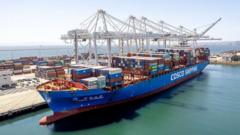The Trump administration has announced a plan to impose port fees on Chinese ships, part of an effort to revive the US shipbuilding industry and diminish China's preeminence in the sector. The US Trade Representative (USTR) indicated that the new fees would take effect in 180 days and escalate over the years, representing a less aggressive approach than a previously proposed $1.5 million charge per Chinese vessel visiting American ports.
The USTR's statement highlighted concerns that China has secured a dominant position, providing a disadvantage to US enterprises and jeopardizing the American economy. The fees for Chinese ship owners will vary based on cargo weight, container counts, or vehicle numbers onboard, thereby implementing a structured financial penalty on foreign seafaring operations.
Initially, Chinese vessels will incur charges of $50 per ton of cargo, increasing by $30 annually for three years. For container ships, a fee of $120 per container will apply, alongside $18 per ton for other Chinese-built ships. Furthermore, non-US built vessels carting automobiles will attract a fee of $150 per vehicle, applied per voyage with a cap of five instances per year.
Certain categories of vessels will be exempt from these fees, including empty bulk carriers and those transporting goods solely between American ports or US territories. The USTR indicated plans for a second phase of regulations favoring US-built ships transporting liquefied natural gas (LNG) to commence in three years.
Experts express concern that these measures could further disrupt global trade flows, as shifts in shipment patterns are already taking place amid Trump’s tariff policies. With tariffs as high as 145% in some instances, cargoes originally set for the US are being rerouted to Europe, leading to price increases for American consumers.
Trade specialists note that the congestion in European ports is worsening, attributed both to US tariffs and strikes at key docking facilities. The trade flow adjustments prompted by the US's tariff regime, with rising import costs, will challenge American consumers while potentially benefiting European markets as they gain unexpected supplies from China.
US tariffs on imports are expected to contribute to a contraction in global trade, raising apprehensions among businesses about long-term impacts on consumer prices and supply chains.




















